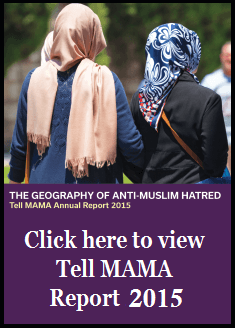The Geography of Anti-Muslim Hatred – Tell MAMA Annual Report 2015
We are going through a turbulent period in our country economically, socially and around the place of migrant and minority communities in the United Kingdom. Many gains have been made since the Windrush generation arrived on the cold shores of this country to work and minority communities have by and large felt settled. The scourge of extremism and issues around identity plague some young people though there have been no major fissures in community relations since the horrendous murder of Stephen Lawrence in the early 90s. His murder was a turning point for our country.
Yet, today we are in a turbulent environment where some politicians think that pointing to posters showing Syrian refugees who are visibly racially and religiously different, is perfectly normal political campaigning. We are in a period where post Brexit, some feel that their hatred and prejudice has been legitimised and we are in a period where terrorism and extremism fuels anti-Muslim hatred.
The upside of this is that anti-Muslim hatred plays into the hands of violent extremists from Muslim communities. It gives credibility and credence to those who say, “see they don’t want you (Muslims) in Europe, so why don’t you go to Syria and Iraq.” These radicalisers rarely give their lives in their extremism, but they generate a lost youth who die in the deserts of a foreign land in the Middle East. This is one of the legacies of anti-Muslim hate, mixed in with a victim culture and with extremist ideology.
We must redouble our efforts collectively to tackle all forms of hate where we find them. In that struggle, we must defeat the forces of anti-Muslim haters who stealthily promote their poison. Muslims are part and parcel of the development of this country and their place in society needs to be defended and protected. We will continue to play a role in a country that values pluralism and which values human rights.
Offline figures trebled in the 2015 calendar year:
The number of offline incidents have trebled from 146 in 2014/15 (12 months to March 2015) to 437 ‘offline’ incidents in the 2015 calendar year. This shows an increase of 300 per cent and there was an increase over time on the previous reporting period by 200 per cent.
‘Offline’ incidents happened in-person between a victim (or property) and a perpetrator.
Anti-Muslim hate impacts Muslims when they travel, shop and socialise in public
Our data shows that the hotspots of anti-Muslim hate occur when Muslims use public and private transport networks, walk in public spaces of cities, and where they do their shopping.
The largest proportion of victims are Muslim women, perpetrators are overwhelmingly male
Muslim women are more likely to be attacked than men in most settings. The largest proportion of perpetrators are white males. This means that the largest proportion of incidents involves Muslim women, usually wearing Islamic clothing – be it the hijab, abaya or niqab. Verbal abuse from men often carries misogynistic, racist and Islamophobic overtones.
Verbal abuse and assaults were most common incident types in offline cases
Of the ‘offline’ cases, 219 involved verbal abuse and 74 involved assault (including common assault, battery, as well as attempted and grievous bodily harm).
Offline incidents by where they occurred

Incidents often occur near major public transport areas
It appears that areas near arterial roads in metropolitan areas experience a relatively higher level of anti-Muslim hate crime. Similarly, 84 per cent of all incidents in London recorded by Tell MAMA and the MPS occurred within 200 metres of a bus stop and 48 per cent of all incidents occurred within 100 metres of a bus stop.
Far-right, nativist hate speech about Muslims and Islam online is being normalised
A majority of cases reported to Tell MAMA in the online sphere concerned hate speech, harassment and bullying on Facebook and Twitter. Our analysis found that nativist, far-right language construed Muslims as violent rapists or terrorists and a cultural threat to Britain. Our data reveals that 45 per cent of perpetrators of online incidents are verifiably supportive of the far-right. If we could not prove far-right affiliation, it demonstrates that far-right narratives are being normalised in online discussions which directly and indirectly target Muslims online.





